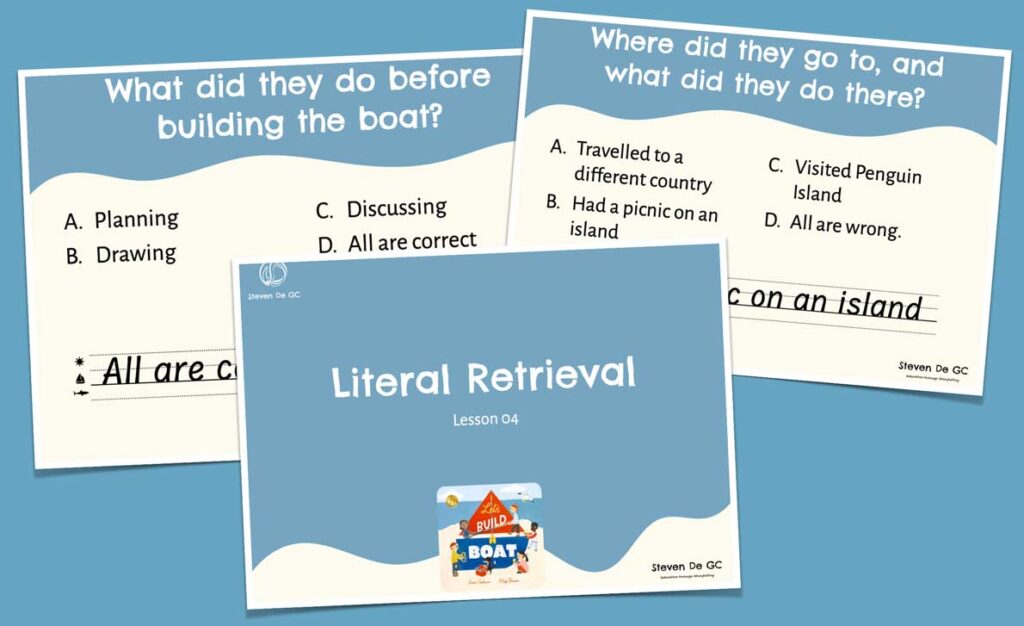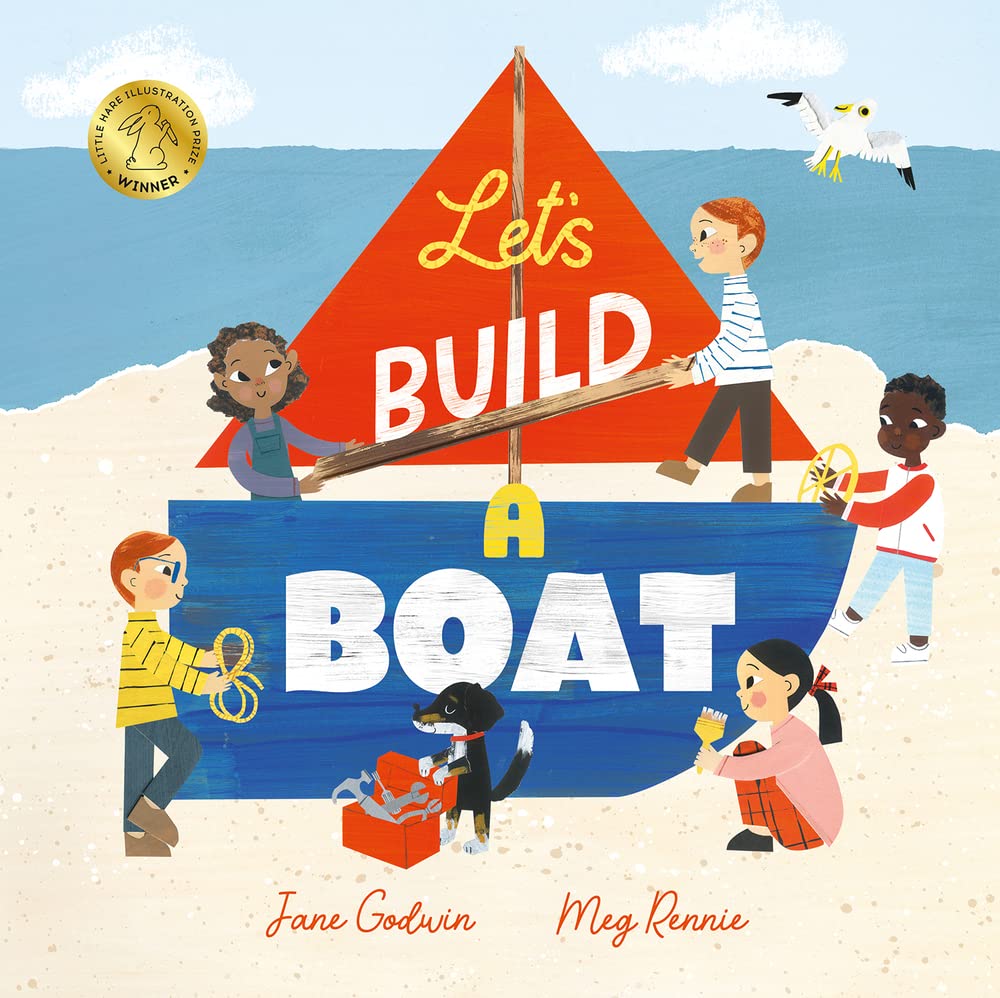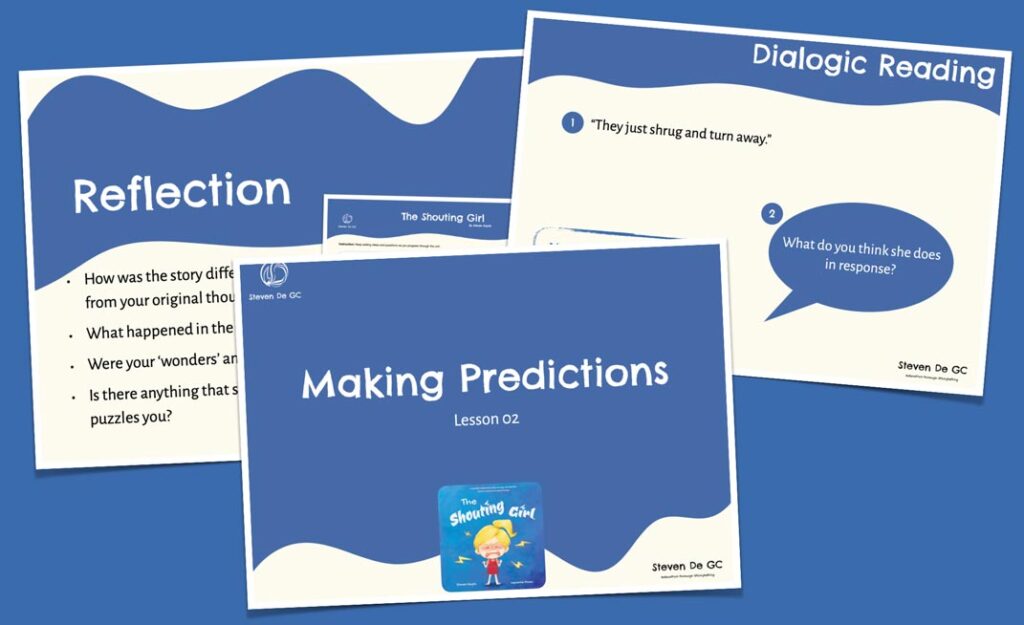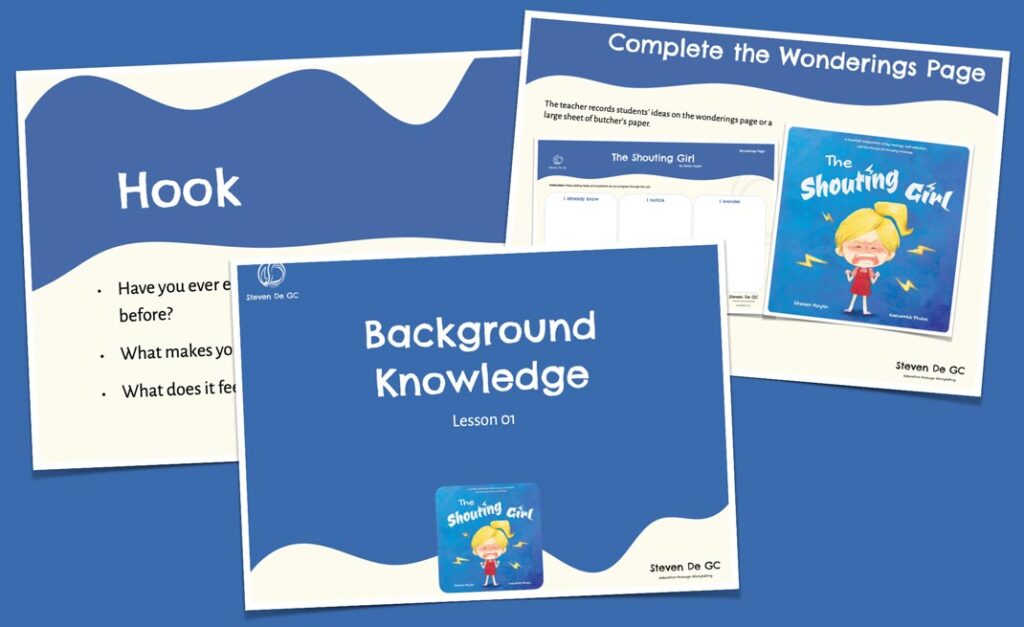- Warm-Up – Retell the Story
- Ask: “What happens at the beginning, middle, and end of the story?”
- Encourage students to share what they remember. Record or list key ideas as a class.
- Third Read – Model Fluency
- Tell students: “As I read today, try to listen closely for what the characters do, how they feel, and what happens next.”
- Read the book again, modelling fluency and expression.
- Whole-Class Question & Answer
- Use the following question bank.
- Read each question aloud and ask students to help answer. For each question, ask: “Where did you find that in the story?” or “How do you know that’s the answer?”
- Encourage evidence-based responses.
- Literal Question Bank:
- What did they do before building the boat?
- How many people made the boat together?
- How did they feel when they had a lot of work to do?
- How did they encourage themselves to keep going?
- What did they think about making the boat?
- Where did they go to, and what did they do there?
- What happened to the boat on the way home?
- How did they reach the bay?
- What did they did at the bay?
- Activity – Reading Comprehension Worksheet
- Students complete the questions independently or with support, using the book as needed.
- Encourage full-sentence answers if appropriate.
[T4R] Let’s Build a Boat: L4 Literal Retrieval

The Book
Let’s Build A Boat
Written by Jane Godwin, illustrated by Meg Rennie, published by Little Hare Books
This inspiring picture book celebrates teamwork, creativity, and determination. As a group of children come together to build a boat for their picnic on an island, the story naturally lends itself to discussions about the purpose of a boat in general and context of the text (AC9TDE2K01 – Years 1 and 2, Design and Technologies). The story also highlights the importance of preparation before they begin (AC9TDE2P01 – Years 1 and 2, Design and Technologies), innovation and problem-solving when they face the challenge at sea (AC9TDE2P03 – Years 1 and 2, Design and Technologies).
Throughout their journey, they experience challenges and moments of joy, allowing students to reflect on how they manage emotions in different situations (AC9HP2P03 – Years 1 and 2, Health and Physical Education). The story also supports children in understanding how teamwork, resilience, and problem-solving help them to achieve shared goals (AC9HP2P01 – Years 1 and 2, Health and Physical Education).
Let’s Build a Boat is a perfect launchpad for hands-on STEM or creative projects, as well as social-emotional learning discussions around collaboration, effort, and celebrating differences.
Resource creator
Steven Huynh
Subject
Description
This lesson supports students in finding key information directly from the text. After a third shared reading, students work together to answer factual questions and then complete a comprehension worksheet using what they remember and observe in the book.
Learning Intentions
• We are learning to find information from the text to help us understand it better.
Successful Criteria
• I can remember important parts of the story.
• I can answer questions about what happened in the story.
• I can say where I found the information in the book.
Curriculum Alignment
AC9E1LE05 9.0 (English Language and Literacy Year 1): Orally retell or adapt a familiar story using plot and characters, language features including vocabulary, and structure of a familiar text, through role-play, writing, drawing or digital tools
• writing character descriptions
• imitating a characteristic piece of speech or dialogue, or the attitudes or expressions of favourite characters in texts
• retelling key events in stories using oral language, visual arts, digital tools or performance
AC9E1LY05 9.0 (English Language and Literacy Year 1): Use comprehension strategies such as visualising, predicting, connecting, summarising and questioning when listening, viewing and reading to build literal and inferred meaning by drawing on vocabulary and growing knowledge of context
• identifying information and details from spoken informative texts
• building topic knowledge and learning new vocabulary before and during reading
• making predictions from the cover, from illustrations and at points in the text before reading on, and confirming and adjusting understanding after reading
• drawing inferences and explaining inferences using clues from the text
• making connections with existing knowledge and personal experiences
AC9E2LY05 9.0 (English Language and Literacy Year 2): Use comprehension strategies such as visualising, predicting, connecting, summarising, monitoring and questioning to build literal and inferred meaning
• listening for specific information and providing key facts or points from an informative or persuasive text
• listening and responding to detailed instructions
• integrating information from print, images and prior knowledge to make supportable inferences
• identifying the main idea of a text
• predicting vocabulary that is likely to be in a text, based on the topic and the purpose of the text; for example, predicting that “station” and “arrive” would be in a text recounting a train journey
• using prior knowledge to make and confirm predictions when reading a text
• using graphic organisers to represent the connections between characters, order of events or sequence of information
Materials
- Let’s Build a Boat by Jane Godwin
- Literal comprehension question worksheet
- Pencils
Instructions
Extensions
- Students can create a new literal question and swap it with a partner to answer. This builds confidence and reinforces comprehension skills.
Downloads
| Free Version | Paid Version | |
|---|---|---|
| Material contents | Limited | Full access |
| Instructions | Not included | Included |
| Redownloads | 5 per download | Unlimited |
| Download | FREE DOWNLOAD | BUY WITH |




![[T4R] Let’s Build a Boat Reading/Design Unit for Year 1/2 [T4R] Let’s Build a Boat Reading/Design Unit for Year 1/2](https://stevendegc.com.au/wp-content/uploads/2025/05/LetsBuildaBoat-T4R-Overview-Cover-1024x626.jpg)


![[T4R] Let’s Build a Boat: L11 Evaluation and Reflection [T4R] Let’s Build a Boat: L11 Evaluation and Reflection](https://stevendegc.com.au/wp-content/uploads/2025/05/LetsBuildaBoat-T4R-Lesson11-Cover-1024x626.jpg)
![[T4R] Let’s Build a Boat: L10 Summarising [T4R] Let’s Build a Boat: L10 Summarising](https://stevendegc.com.au/wp-content/uploads/2025/05/LetsBuildaBoat-T4R-Lesson10-Cover-1024x626.jpg)
![[T4R] Let’s Build a Boat: L9 Making Inferences [T4R] Let’s Build a Boat: L9 Making Inferences](https://stevendegc.com.au/wp-content/uploads/2025/05/LetsBuildaBoat-T4R-Lesson9-Cover-1024x625.jpg)
![[T4R] Let’s Build a Boat: L6 Writing a Boat-making Procedure [T4R] Let’s Build a Boat: L6 Writing a Boat-making Procedure](https://stevendegc.com.au/wp-content/uploads/2025/05/LetsBuildaBoat-T4R-Lesson6-Cover-1024x626.jpg)
![[T4R] Let’s Build a Boat: L5 Connecting to a Different Text [T4R] Let’s Build a Boat: L5 Connecting to a Different Text](https://stevendegc.com.au/wp-content/uploads/2025/05/LetsBuildaBoat-T4R-Lesson5-Cover-1024x626.jpg)
![[T4R] Let’s Build a Boat: L3 Making Connections [T4R] Let’s Build a Boat: L3 Making Connections](https://stevendegc.com.au/wp-content/uploads/2025/05/LetsBuildaBoat-T4R-Lesson3-Cover-1024x625.jpg)
![[T4R] Let’s Build a Boat: L2 Making Predictions [T4R] Let’s Build a Boat: L2 Making Predictions](https://stevendegc.com.au/wp-content/uploads/2025/05/LetsBuildaBoat-T4R-L2-Cover-1024x627.jpg)
![[T4R] Let’s Build a Boat: L1 Background Knowledge [T4R] Let’s Build a Boat: L1 Background Knowledge](https://stevendegc.com.au/wp-content/uploads/2025/05/LetsBuildaBoat-T4R-L1-Cover-1024x626.jpg)
Leave a Reply